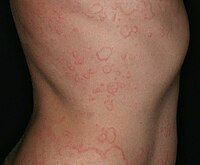
Photo from wikipedia
BACKGROUND The aim of our study was to report our experience in the classification and therapeutic management strategies for spontaneous perirenal hemorrhage (SPH). METHODS From September 2005 to April 2015,… Click to show full abstract
BACKGROUND The aim of our study was to report our experience in the classification and therapeutic management strategies for spontaneous perirenal hemorrhage (SPH). METHODS From September 2005 to April 2015, 20 patients with SPH were newly diagnosed in our hospital. Their clinical features, image findings, identification of underlying causes, and therapeutic management were retrospectively analyzed, and relevant literature was reviewed. In this study, patients were classified according to the degree of severity of the disease or emergency imaging diagnosis of underlying causes. On the basis of the former, patients were classified as critical and noncritical, and on the basis of the latter, patients were classified as renal cell carcinoma (RCC), undefined solid neoplasm, angioleiomyolipoma (AML), and unknown cause. RESULTS In the acute stage, contrast-enhanced computed tomography (CT) was superior to ultrasonography for both diagnostic accuracy of SPH (p = 0.02) and etiology discovery power (p = 0.004). The results of contrast-enhanced magnetic resonance imaging (MRI) were identical to those of contrast-enhanced CT. We summarized a flowchart in the whole classification and therapeutic strategies of SPH. According to the imaging diagnosis of underlying causes, all the patients with undefined solid neoplasm or RCC underwent emergency operation. Patients with AML or unknown cause underwent selective arterial embolization (SAE) or conservative management according to the critical degree. Acute hemorrhage was controlled in 19 cases, of which 14 were cured by the operation and only one critical patient with severe shock died shortly despite rescue efforts. CONCLUSIONS Contrast-enhanced CT or MRI is the first choice of imaging examination, which could not only accurately diagnose SPH but also detect the underlying causes. Choice of therapeutic strategies for SPH should vary according to the identification of critical patients and imaging diagnosis of underlying cause.
Journal Title: International journal of surgery
Year Published: 2018
Link to full text (if available)
Share on Social Media: Sign Up to like & get
recommendations!